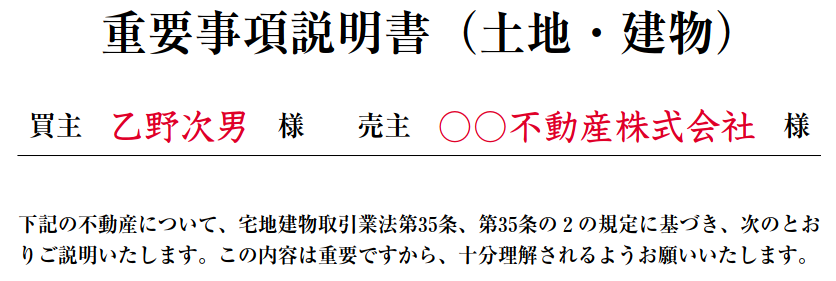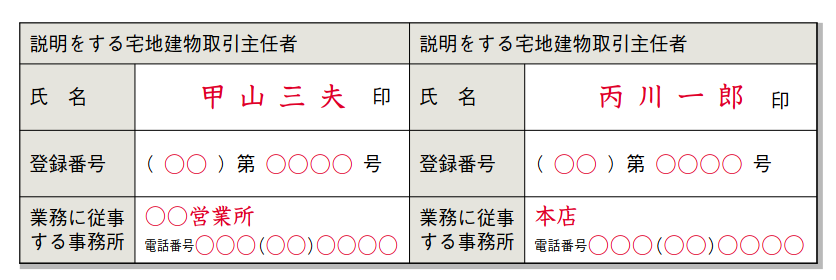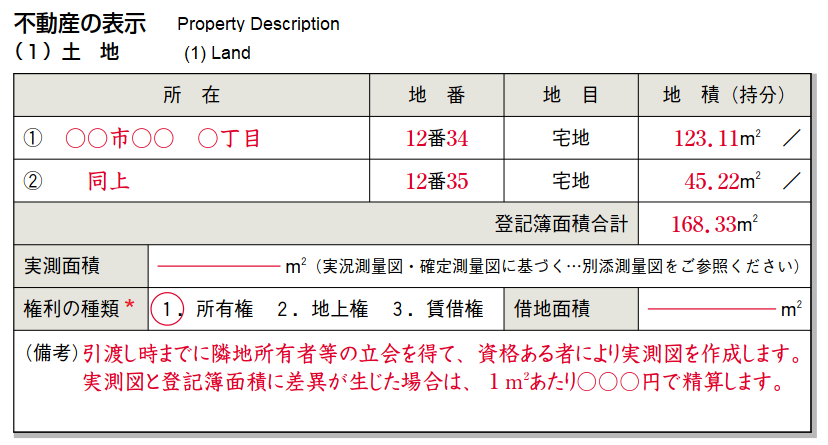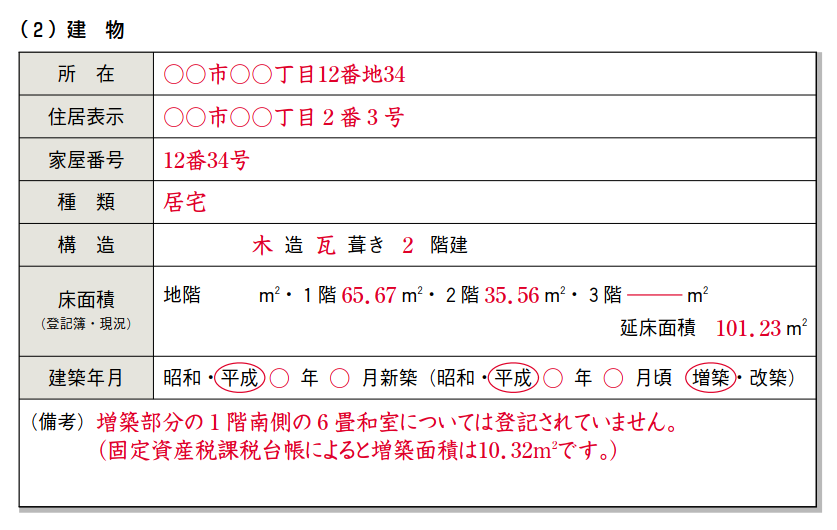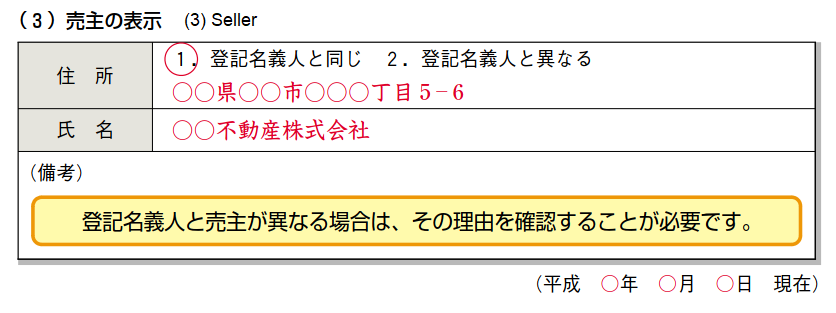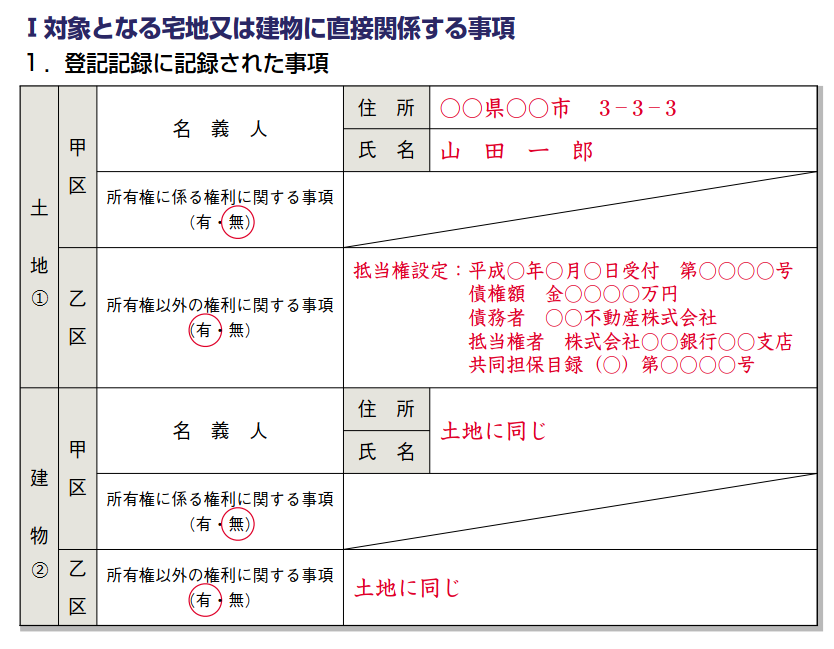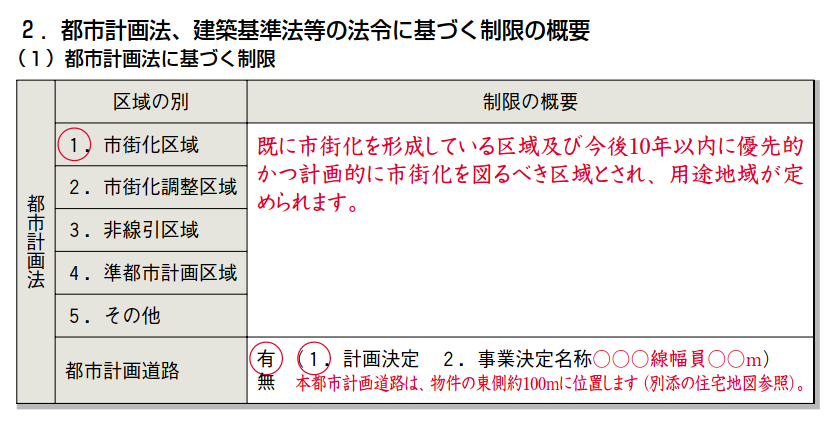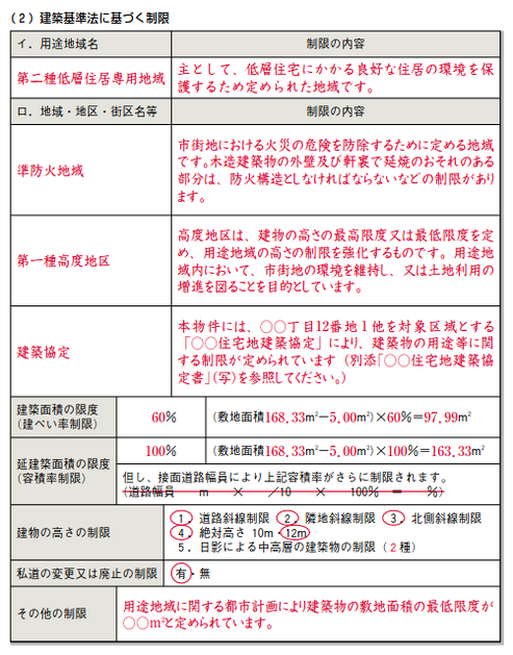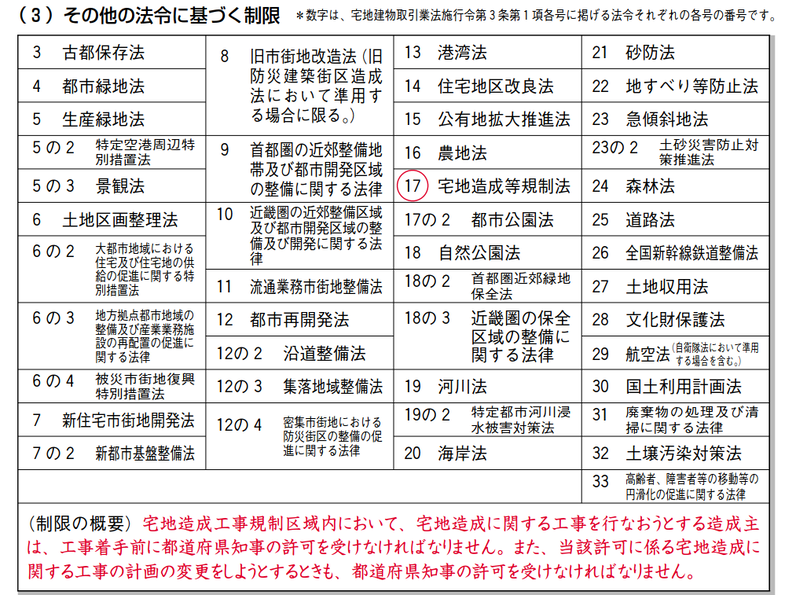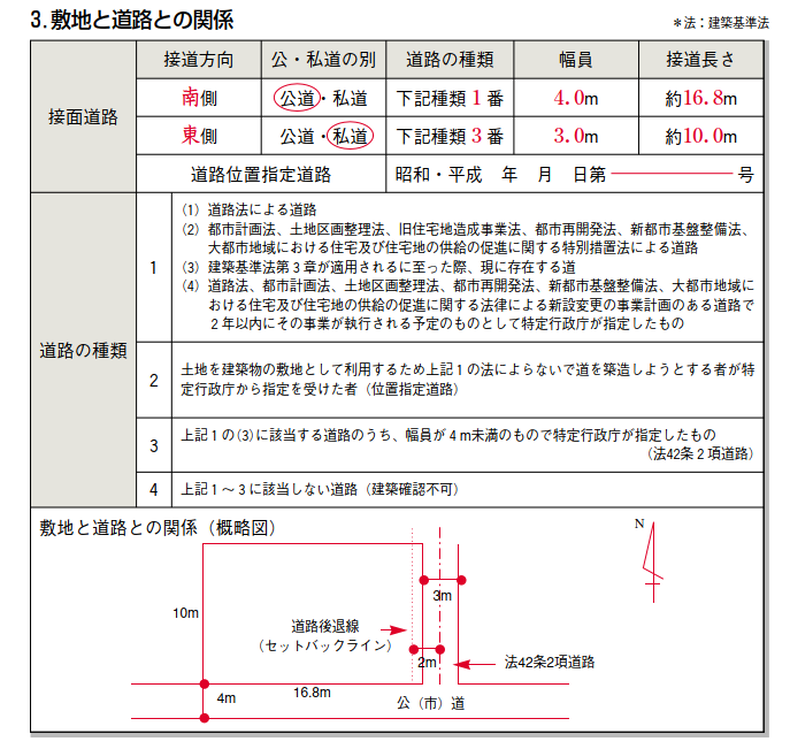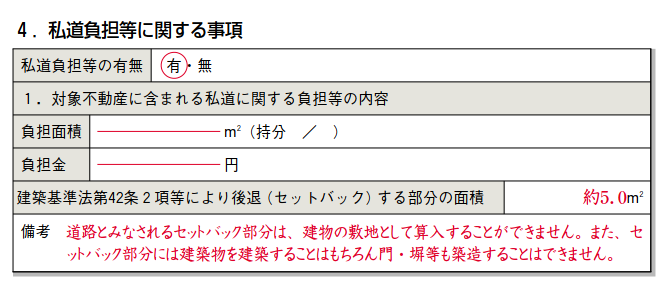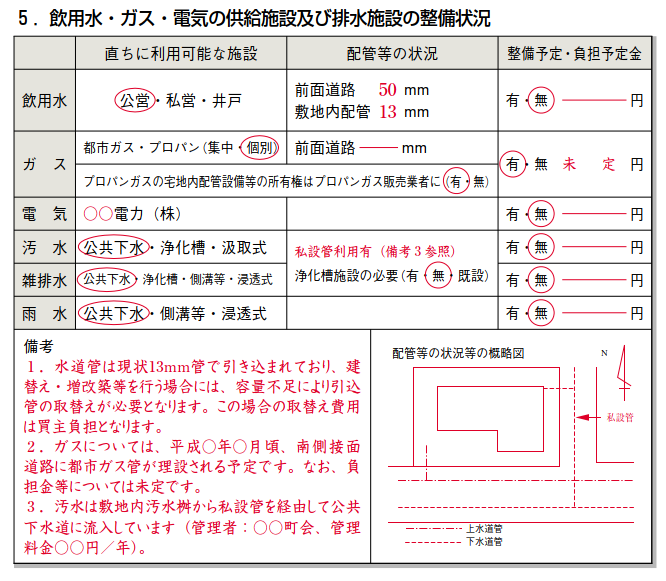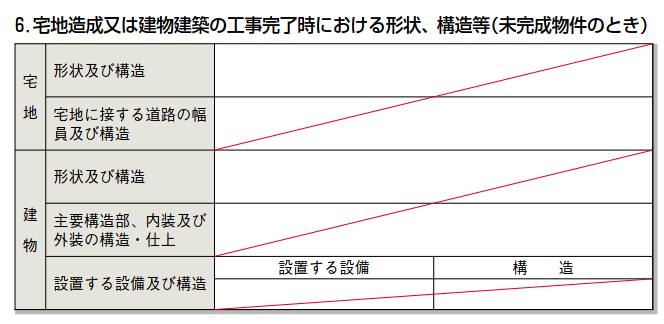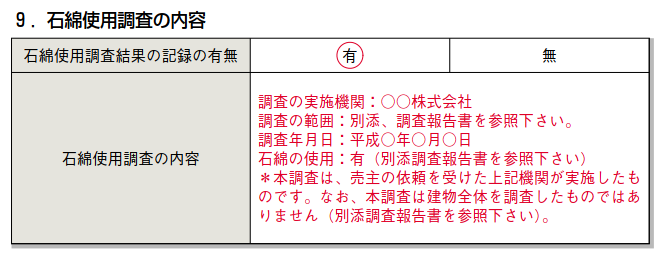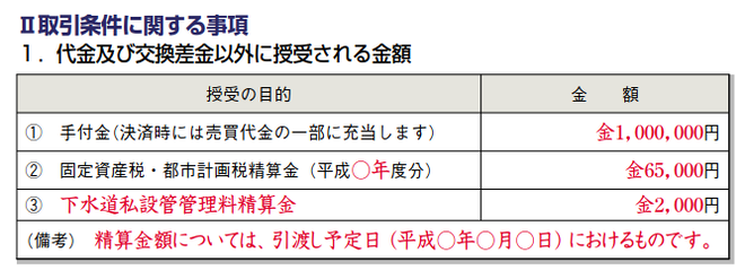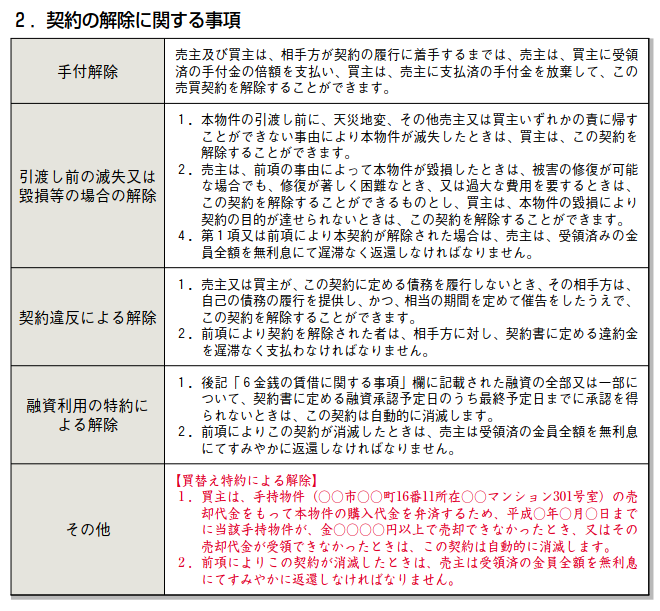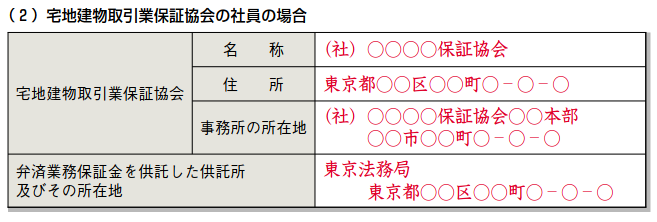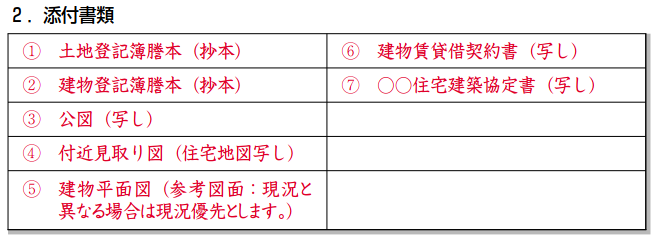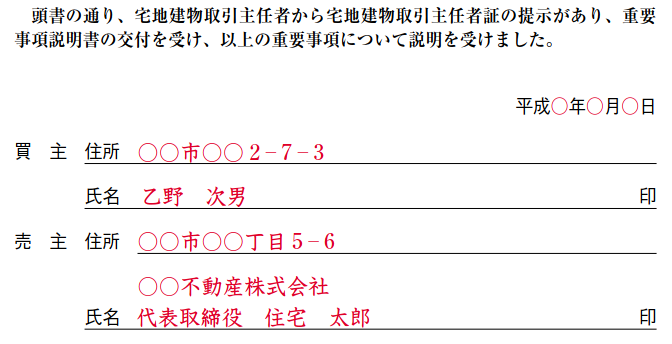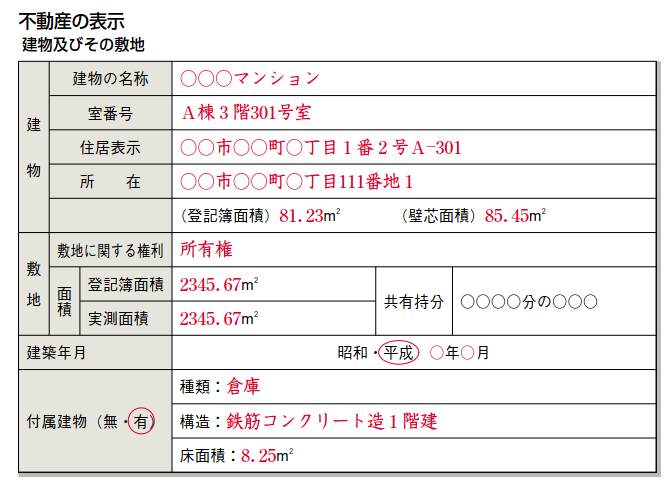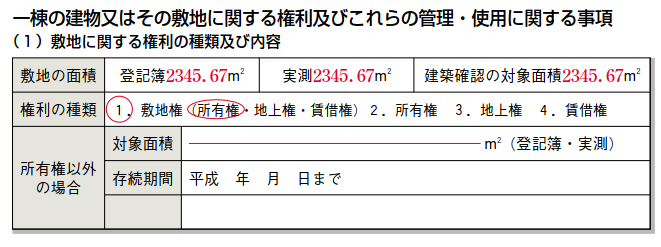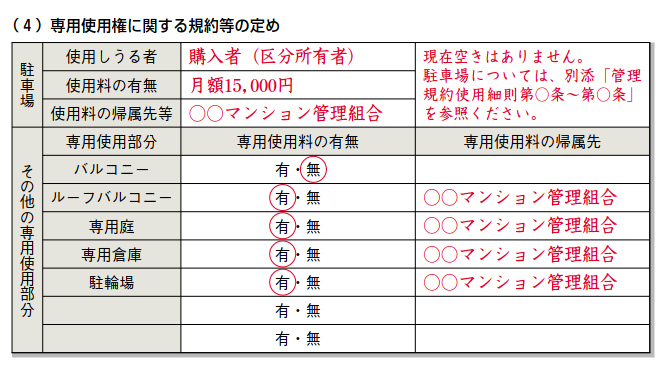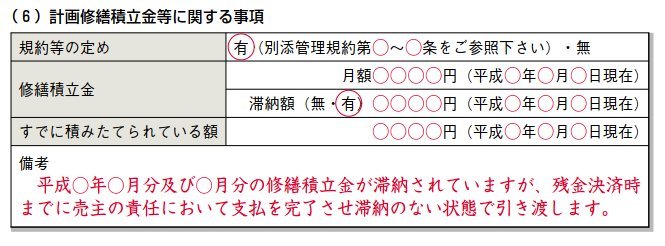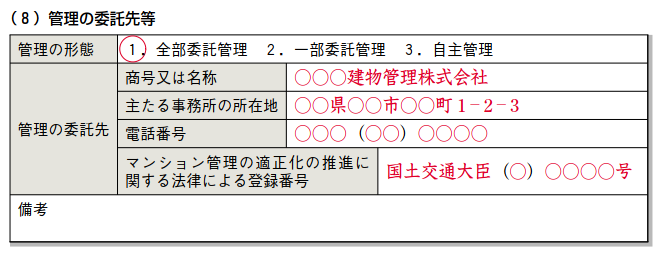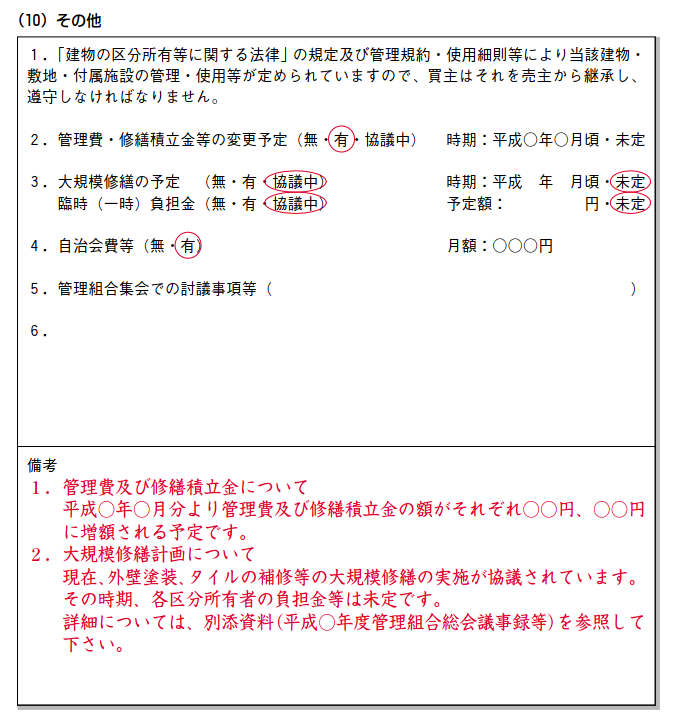Jyuyojiko Setsumeisho (Important Points Explanation)
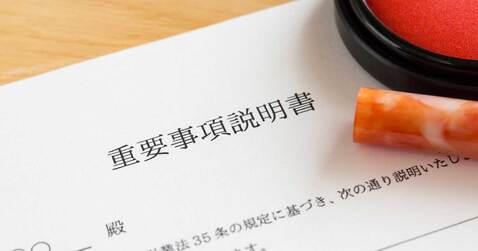
What is "Juyojiko Setsumeisho" (Important Points Explanation)?
It is a real-estate-contract disclosure statement that contains important contract clauses and essential factors regarding the property, the conditions of the transactions, and the rights of a buyer or a renter. The contents of the statement is to be explained upon conclusion of the contract. The purpose of "Juyo Jiko Setsumeisho" is to protect the rights of a buyer or a renter and to prevent future disputes and/or trouble among the parties concerned.
It is a real-estate-contract disclosure statement that contains important contract clauses and essential factors regarding the property, the conditions of the transactions, and the rights of a buyer or a renter. The contents of the statement is to be explained upon conclusion of the contract. The purpose of "Juyo Jiko Setsumeisho" is to protect the rights of a buyer or a renter and to prevent future disputes and/or trouble among the parties concerned.
The disclosure statement called "Juyojiko Setsumeisho" contains the following:
I. Matters directly related to the residential land or building
- Matters described in the registration record
- Outline of restrictions based on the City Planning Law, Building Standards Law, and other laws and regulations
- Matters concerning private road contribution
- Conditions of drinking water, electricity, and gas supply facilities and drainage facilities
- Shape, structure, etc. at the time of completion of the construction of housing lots or buildings (in the case of an unfinished property)
- Whether or not the building or the land is located in a disaster-prone developed residential area
- Whether or not the building is located in a landslide disaster prevention zone
- Details of asbestos testing
- Details of seismic diagnosis
- In the case of a new house evaluated for housing performance:
Whether or not a housing performance evaluation certificate has been issued
II. Matters related to the terms and conditions of the transaction
- Amounts received and paid other than the property price and difference arising from the exchange of the property
- Matters concerning the cancellation of contracts
- Matters concerning the compensation for damages or penalties
- Outline of measures to secure deposits, etc. (when the real estate agency is the seller)
- Loan mediation
- Outline of measures to be taken with regard to warranty against defects
- Matters regarding installment payments
III. Others:
1. Matters concerning an official depository
*Others matters that may significantly affect the interests of the parties involved will also be described and explained.
1. Matters concerning an official depository
*Others matters that may significantly affect the interests of the parties involved will also be described and explained.
In the case of a building that is subject to unit ownership (a condominium building, an apartments, etc.), the following are included:
Rights related to the building and land and matters related to the management and use of the building and land
Rights related to the building and land and matters related to the management and use of the building and land
- The types and details of the rights to the land
- Provisions regarding common areas
- Provisions regarding the use of exclusive areas and other restrictions on use, etc.
- Provisions regarding the rights to exclusive use, etc.
- Exceptional provisions, such as the provision to reduce or exempt one from expenses to be borne by the owner under special circumstances.
- Matters related to the reserve for planned repairs, etc.
- General management costs
- Management company
- Records of the status of building maintenance and repair
- Others
Jyuyojiko Setsumeisho Sample for a Single-Family Home (Land and Building)
The first very first line is the title of the document: Important Points Explanation (Land/Building).
The second line states (1) the name of the buyer/renter and (2) the seller/owner, and the lines below explain the purpose of this document: "The following details on the property have been written in accordance with Article 35 of the Real Estate Act. These essential points are to be understood by the parties involved."
The second line states (1) the name of the buyer/renter and (2) the seller/owner, and the lines below explain the purpose of this document: "The following details on the property have been written in accordance with Article 35 of the Real Estate Act. These essential points are to be understood by the parties involved."
The column above contains the information about the real estate agencies involved in this transaction: license numbers, addresses, and names with personal or company seals.
The second column contains the information about the real estate agents who explain the contents of the documents: names, license numbers, office names/phone numbers.
* The number in parentheses indicates how many times the license has been renewed, meaning that the larger the number, the longer the agency has been in the real estate business.
* The number in parentheses indicates how many times the license has been renewed, meaning that the larger the number, the longer the agency has been in the real estate business.
The next column states the conditions of the transactions: purchase/rent, owner/representative/intermidiary, etc.
Property Description
The next section shows the property details.
In (1) the land description, the address/location, land type (residential, field, forest etc.), land area (㎡), measurement method, type of property rights (1. ownership 2. superficies 3. leasehold)* are indicated with notes if any, such as the comments below:
"The actual measurement drawing will be made by a qualified person with the presence of the neighboring landowner, etc. by the time of delivery. If there is any difference between the actual measurement and the registered area, the difference will be settled at ___ yen per square meter."
*Make sure to confirm the type of rights attached to the property (1. ownership 2. superficies 3. leasehold) upon concluding the contract, in order to avoid possible future dispute and trouble. Please also note the following with regard to land leases:
There are two types of land lease rights: superficies and leasehold. Although the superficies right is a very strong right, the leasehold right is the most common type of land leases. Leasehold rights are often not registered, but if you own a building on the land that is registered in the name of the leaseholder, you can use this to oppose a third party.
Notes: There are two types of land sales: registered land sales, in which transactions are conducted using the area described in the register, and measured land sales, in which the actual measured area is used as the transaction area. In the case of a sale by registry, the difference between the publicly offered area and the measured area will not be counted. It is important to confirm which method is used, registered land sales or measured land sales.
"The actual measurement drawing will be made by a qualified person with the presence of the neighboring landowner, etc. by the time of delivery. If there is any difference between the actual measurement and the registered area, the difference will be settled at ___ yen per square meter."
*Make sure to confirm the type of rights attached to the property (1. ownership 2. superficies 3. leasehold) upon concluding the contract, in order to avoid possible future dispute and trouble. Please also note the following with regard to land leases:
There are two types of land lease rights: superficies and leasehold. Although the superficies right is a very strong right, the leasehold right is the most common type of land leases. Leasehold rights are often not registered, but if you own a building on the land that is registered in the name of the leaseholder, you can use this to oppose a third party.
Notes: There are two types of land sales: registered land sales, in which transactions are conducted using the area described in the register, and measured land sales, in which the actual measured area is used as the transaction area. In the case of a sale by registry, the difference between the publicly offered area and the measured area will not be counted. It is important to confirm which method is used, registered land sales or measured land sales.
In (2) the building column, the address/location, house number, building type (residence, office, etc.), structure (wooden, RC, etc.), floor area (㎡)*, date of construction, and other details are indicated with notes if any, such as the comments below:
"The 6-mat Japanese-style room on the south side of the first floor of the extension is not registered. (The area of the extension is 10.32㎡ according to the fixed asset taxation ledger.)"
Notes: The current area of the building may differ from the area recorded in the registry for reasons such as the non-registered extension. Check official records such as the fixed asset taxation ledger to confirm the current area. Obtain the blueprint of the building, if available, as it will be useful when you consider remodeling the building.
"The 6-mat Japanese-style room on the south side of the first floor of the extension is not registered. (The area of the extension is 10.32㎡ according to the fixed asset taxation ledger.)"
Notes: The current area of the building may differ from the area recorded in the registry for reasons such as the non-registered extension. Check official records such as the fixed asset taxation ledger to confirm the current area. Obtain the blueprint of the building, if available, as it will be useful when you consider remodeling the building.
In (3) Seller, the address and name of the seller and as of when (year/month/date) are indicated with notes if any.
Notes: If the registered owner and the seller are different, it is necessary to clarify the reason for the difference.
Notes: If the registered owner and the seller are different, it is necessary to clarify the reason for the difference.
I . Items Directly Related to the Land and Building
1. Items Recoded in the Registry
In this section, items recorded in the registry are disclosed: the name(s) and address(es) of the land/building owner and the rights attached to the land/building, etc., with notes if any.
In this section, items recorded in the registry are disclosed: the name(s) and address(es) of the land/building owner and the rights attached to the land/building, etc., with notes if any.
①土地 Land
甲区: As a general rule, the registered owner listed in the "甲区" column is the current owner.
The matters to be noted with regard to the ownership are also disclosed here.
In the above sample, "無" is circled in red, meaning that there is nothing to be noted as for the ownership.
乙区: The rights other than ownership (mortgage, easement, etc.) may be listed in the "乙区" column.
In the above sample, "有" is circled in red, meaning that there are matters to be noted as for the rights other than ownership, and the details of the mortgage set on the property are disclosed on the right side. The details in the above include the name of right attached to the property (mortgage), the date and serial number of mortgage set, the amount of loan, the name of the debtor, the name of the mortgage holder, and the serial number of the joint collateral inventory.
②建物 Building
甲区: As a general rule, the registered owner listed in the "甲区" column is the current owner.
The above sample shows the registered owner of the building as the same as that of the land ("土地に同じ”).
乙区: The rights other than ownership attached to the property (mortgage, easement, etc.) may be listed in the "乙区" column. In the above sample, "有" is circled in red, meaning that there are matters to be noted as for the rights other than ownership. The above sample states the same as those of the land ("土地に同じ”).
Notes: Pay special attention to the "matters related to the right of ownership" in the "甲区" column. "有" (Yes) or "無" (No) is circled to indicate whether there is any matter to be noted as to the ownership. "Yes" indicates that such as the following may be recorded in the registry: provisional registration of transfer of ownership, registration of seizure, registration of special repurchase agreement. With these registrations attached, even if you have the transfer of ownership (from the previous owner to you) registered in the official record, it may not mean you have acquired the ownership.
甲区: As a general rule, the registered owner listed in the "甲区" column is the current owner.
The matters to be noted with regard to the ownership are also disclosed here.
In the above sample, "無" is circled in red, meaning that there is nothing to be noted as for the ownership.
乙区: The rights other than ownership (mortgage, easement, etc.) may be listed in the "乙区" column.
In the above sample, "有" is circled in red, meaning that there are matters to be noted as for the rights other than ownership, and the details of the mortgage set on the property are disclosed on the right side. The details in the above include the name of right attached to the property (mortgage), the date and serial number of mortgage set, the amount of loan, the name of the debtor, the name of the mortgage holder, and the serial number of the joint collateral inventory.
②建物 Building
甲区: As a general rule, the registered owner listed in the "甲区" column is the current owner.
The above sample shows the registered owner of the building as the same as that of the land ("土地に同じ”).
乙区: The rights other than ownership attached to the property (mortgage, easement, etc.) may be listed in the "乙区" column. In the above sample, "有" is circled in red, meaning that there are matters to be noted as for the rights other than ownership. The above sample states the same as those of the land ("土地に同じ”).
Notes: Pay special attention to the "matters related to the right of ownership" in the "甲区" column. "有" (Yes) or "無" (No) is circled to indicate whether there is any matter to be noted as to the ownership. "Yes" indicates that such as the following may be recorded in the registry: provisional registration of transfer of ownership, registration of seizure, registration of special repurchase agreement. With these registrations attached, even if you have the transfer of ownership (from the previous owner to you) registered in the official record, it may not mean you have acquired the ownership.
2. The Outline of Restrictions under the City Planning Law, Building Standards Law, and Other Laws and Regulations
(1) Restrictions under the City Planning Law
(1) Restrictions under the City Planning Law
In this section, the outline of restrictions under the City Planning Law is disclosed.
This section defines which of the following areas the property is located under the City Planning Law:
1. Urbanization Promotion Area (市街化区域)
2. Urbanization Control Area (市街化調整区域)
3. Undefined Area (非線引き区域)
4. Quasi-urban Planning Area (準都市計画区域)
5. Other (その他)
In the above sample, 1.市街化区域 is circled in red, meaning that the property is located in an urbanization promotion area. The definition of the area is on the right column: it is defined as an area where urbanization is already underway and an area where urbanization should be prioritized and planned within the next 10 years.
The information on urban planning roads (都市計画道路) is also disclosed in this section.
In the above sample, 有 is circled in red in the lower column, indicating that there is a construction plan for an urban road. (1. Plan: This urban planning road is located approximately 100 meters to the east of the property. 2. Project name: OOOLine Width OOm) (See the attached housing map.)
Notes: As a general rule, no building can be constructed on land in an urbanization control area.
This section defines which of the following areas the property is located under the City Planning Law:
1. Urbanization Promotion Area (市街化区域)
2. Urbanization Control Area (市街化調整区域)
3. Undefined Area (非線引き区域)
4. Quasi-urban Planning Area (準都市計画区域)
5. Other (その他)
In the above sample, 1.市街化区域 is circled in red, meaning that the property is located in an urbanization promotion area. The definition of the area is on the right column: it is defined as an area where urbanization is already underway and an area where urbanization should be prioritized and planned within the next 10 years.
The information on urban planning roads (都市計画道路) is also disclosed in this section.
In the above sample, 有 is circled in red in the lower column, indicating that there is a construction plan for an urban road. (1. Plan: This urban planning road is located approximately 100 meters to the east of the property. 2. Project name: OOOLine Width OOm) (See the attached housing map.)
Notes: As a general rule, no building can be constructed on land in an urbanization control area.
(2) Restrictions under the Building Standards Law
イ. 用途地域名:A Zoning Area
Zoning areas refer to areas divided into 13 areas according to use in order to form a planned urban area.
In the above sample, the zoning area is 第二種低層住宅専用地域 (Category II medium-to-high-rise exclusive residential area) with the outline of the restriction on the area on the left column.
ロ. 地域・地区・街区名等:Area, District, Town, etc.
On the left side in (ロ)in the above sample are written 準防火地域 (Quasi-fire Prevention area), 第一種高度地区 (Category I high altitude district), and 建築協定(Building agreement), with the outline of the restrictions on the left columns.
建ぺい率の限度(建ぺい率の制限):Building-to-land ratio limits (Building-to-land ratio restrictions)
In the above sample,
60 % (Land Area 168.33㎡ ー 5.00㎡) x 60% = 97.99㎡
延建築面積の限度(容積率制限): Limit on the Total Building Area (Floor-area-ratio Limit)
100% (Land Area 168.33㎡ ー 5.00㎡) x 100% = 163.33㎡
*However, the above floor-area ratio will be further restricted depending on the width of the road that the property faces.
(Road width m x /10 X 100% = %) In the above sample, this line is crossed out as it is non-applicable to this property.
建物の高さの制限: Building Height Restrictions
1. Setback regulation from road width
2. Neighboring diagonal line restriction
3. North side slant line regulation
4. Absolute height 10m / 12m
5. Restrictions on medium and high-rise buildings due to shading (Category 2)
私道の変更または廃止の制限: Restrictions on Alteration or Elimination of Private Roads
Yes / No
その他の制限: Other Restrictions
ex) The minimum land area for a building is set at OO㎡ according to the city planning regarding the zoning area.
*In principle, no building can be constructed on land in an area with a minimum land area limit unless the land area is greater than the minimum area limit.
Notes: Check carefully to see if you can build the building you want and what building restrictions are in place. The width of the front road may further restrict the floor area ratio.
Zoning areas refer to areas divided into 13 areas according to use in order to form a planned urban area.
In the above sample, the zoning area is 第二種低層住宅専用地域 (Category II medium-to-high-rise exclusive residential area) with the outline of the restriction on the area on the left column.
ロ. 地域・地区・街区名等:Area, District, Town, etc.
On the left side in (ロ)in the above sample are written 準防火地域 (Quasi-fire Prevention area), 第一種高度地区 (Category I high altitude district), and 建築協定(Building agreement), with the outline of the restrictions on the left columns.
建ぺい率の限度(建ぺい率の制限):Building-to-land ratio limits (Building-to-land ratio restrictions)
In the above sample,
60 % (Land Area 168.33㎡ ー 5.00㎡) x 60% = 97.99㎡
延建築面積の限度(容積率制限): Limit on the Total Building Area (Floor-area-ratio Limit)
100% (Land Area 168.33㎡ ー 5.00㎡) x 100% = 163.33㎡
*However, the above floor-area ratio will be further restricted depending on the width of the road that the property faces.
(Road width m x /10 X 100% = %) In the above sample, this line is crossed out as it is non-applicable to this property.
建物の高さの制限: Building Height Restrictions
1. Setback regulation from road width
2. Neighboring diagonal line restriction
3. North side slant line regulation
4. Absolute height 10m / 12m
5. Restrictions on medium and high-rise buildings due to shading (Category 2)
私道の変更または廃止の制限: Restrictions on Alteration or Elimination of Private Roads
Yes / No
その他の制限: Other Restrictions
ex) The minimum land area for a building is set at OO㎡ according to the city planning regarding the zoning area.
*In principle, no building can be constructed on land in an area with a minimum land area limit unless the land area is greater than the minimum area limit.
Notes: Check carefully to see if you can build the building you want and what building restrictions are in place. The width of the front road may further restrict the floor area ratio.
(3) Restrictions under Other Laws and Regulations
This section indicates what restrictions under other laws and regulations are applicable to the property in question. In the sample below, the number 17 is circled in red, meaning that the property is subject to restrictions under the Act on Regulation of Residential Land Development (宅地造成等規制).
* The numbers in the chart below are the numbers for each of the laws and regulations listed in Article 3, Clause 1 of the Order for Enforcement of the Building Lots and Buildings Transaction Business Law.
* The numbers in the chart below are the numbers for each of the laws and regulations listed in Article 3, Clause 1 of the Order for Enforcement of the Building Lots and Buildings Transaction Business Law.
The restriction summary may also be included in this section.
In the above sample, the summary of the restrictions under (17) the Act on Regulation of Residential Land Development can be found at the end of the chart:
(制限の概要)
In a residential land development control area, a land developer who intends to carry out construction work related to residential land development must obtain permission from the prefectural governor before starting the work. In addition, when a land developer intends to change the construction plan for residential land development related to the permission, he/she must also obtain the permission from the prefectural governor.
Note: It is important for the buyer/renter to understand the details of the restrictions, if applicable, since the construction and use may be strictly inhibited by them.
In the above sample, the summary of the restrictions under (17) the Act on Regulation of Residential Land Development can be found at the end of the chart:
(制限の概要)
In a residential land development control area, a land developer who intends to carry out construction work related to residential land development must obtain permission from the prefectural governor before starting the work. In addition, when a land developer intends to change the construction plan for residential land development related to the permission, he/she must also obtain the permission from the prefectural governor.
Note: It is important for the buyer/renter to understand the details of the restrictions, if applicable, since the construction and use may be strictly inhibited by them.
3. The Land and the Road
In this section, the road in relation to the land is explained: road type, approach direction, width, frontage, etc.
Note: Carefully check the information on the road (the type, width, frontage, etc.).
In principle, a building cannot be constructed unless the land faces a road classified as such in accordance with the Building Standards Act for at least 2 meters.
Note: Carefully check the information on the road (the type, width, frontage, etc.).
In principle, a building cannot be constructed unless the land faces a road classified as such in accordance with the Building Standards Act for at least 2 meters.
In the above sample, the property faces roads on the south and east sides.
Access Roads:
The overview of the road types (1 to 4) can be found in the middle section:
1.
(1) Roads under the Road Act
(2) Roads under the City Planning Law, Land Readjustment Law, Old Housing Development Project Law, Urban Redevelopment Law, New Urban Infrastructure Development Law, and Law on Special Measures to Promote the Supply of Residential Land in Large Urban Areas
(3) Roads that were in existence when Chapter 3 of the Building Code became applicable.
(4) Roads with new construction and alteration project plans under the Road Act, City Planning Act, Land Readjustment Act, Urban Redevelopment Act, New Urban Infrastructure Development Act, and Act on Promotion of Housing and Residential Land Supply in Urban Areas, which are designated by the specified administrative agency as those whose projects are to be executed within 2 years
2. Roads that have been designated by the specified administrative agency for those who intend to construct a road not in accordance with the law in 1 above in order to use the land as a site for a building (Location-designated road).
3. Roads that have been designated by the specified administrative agency for those who intend to construct a road not in accordance with the law in 1 above in order to use the land as a site for a building (Location-designated road).
4. Roads that do not fall under 1-3 above (building permit not available
Access Roads:
- On the south side, the road is a public road (type 1) with 4.0m in width and about 16.8m in frontage.
- On the east side, the road is a private road (type 3) with 3.0m in width and about 10.0 in frontage.
- There is no location-designated road.
The overview of the road types (1 to 4) can be found in the middle section:
1.
(1) Roads under the Road Act
(2) Roads under the City Planning Law, Land Readjustment Law, Old Housing Development Project Law, Urban Redevelopment Law, New Urban Infrastructure Development Law, and Law on Special Measures to Promote the Supply of Residential Land in Large Urban Areas
(3) Roads that were in existence when Chapter 3 of the Building Code became applicable.
(4) Roads with new construction and alteration project plans under the Road Act, City Planning Act, Land Readjustment Act, Urban Redevelopment Act, New Urban Infrastructure Development Act, and Act on Promotion of Housing and Residential Land Supply in Urban Areas, which are designated by the specified administrative agency as those whose projects are to be executed within 2 years
2. Roads that have been designated by the specified administrative agency for those who intend to construct a road not in accordance with the law in 1 above in order to use the land as a site for a building (Location-designated road).
3. Roads that have been designated by the specified administrative agency for those who intend to construct a road not in accordance with the law in 1 above in order to use the land as a site for a building (Location-designated road).
4. Roads that do not fall under 1-3 above (building permit not available
An outlie drawing showing the layout of the property and the road(s) may also be included in this section.
Note: To avoid road-related troubles and disputes, fully understand the relationship between the site and the road. Please also note that if the road in front of your property is a private road, you may be required to obtain the private road owner's approval to pass, dig, and pay a fee.
4. Matters Related to Private Road Contributions
The above sample states that private road contributions are available:
The area set back by Article 42 Clause 2 of the Building Standard Law is approximately 5.0㎡.
Note: Setback areas that are considered roads cannot be included in the building site. In addition, no buildings, gates, fences, etc. may be constructed in the setback area.
What is the setback?
The width of the road must be at least 4 m. If the road is less than 4 m, buildings, gates, fences, etc. must be 2 m from the center line of the road so that the road is at least 4 m wide. The setback is considered to be a road (deemed road).
The area set back by Article 42 Clause 2 of the Building Standard Law is approximately 5.0㎡.
Note: Setback areas that are considered roads cannot be included in the building site. In addition, no buildings, gates, fences, etc. may be constructed in the setback area.
What is the setback?
The width of the road must be at least 4 m. If the road is less than 4 m, buildings, gates, fences, etc. must be 2 m from the center line of the road so that the road is at least 4 m wide. The setback is considered to be a road (deemed road).
5. The conditions of Utilities (Drinking Water, Gas, Electricity, and Sewerage)
If facilities essential for daily life such as those for electricity, gas, water, and sewerage are not in place, a large amount of money may be required to install and/or maintain them. To avoid future trouble and dispute, check the conditions of these fundamental facilities.
Note: Buried water pipes in the front road may be private pipes. In the case of private pipes, a contribution payment may be required. Also, if the diameter of the water main is small, it may be necessary to change the diameter when rebuilding or renovating the house.
Note: Buried water pipes in the front road may be private pipes. In the case of private pipes, a contribution payment may be required. Also, if the diameter of the water main is small, it may be necessary to change the diameter when rebuilding or renovating the house.
In the above sample, the conditions of utilities and drainage are as follows:
Drinking Water:
Drinking Water:
- Public
- Pipe: 50mm (the front road), 13mm (within the property)
- No contribution required
- City gas and propane (Individually supplied)
- Contribution required (To be determined)
- ______ Electricity
- No contribution required
- Sewerage: Public (Private Pipe. See Note 3 below. No septic tank needed. No contribution required.)
- Miscellaneous: Public (Private Pipe. See Note 3 below. No septic tank needed. No contribution required.)
- Rainwater: Public (No contribution required.)
- Water pipes are currently drawn in with 13mm pipes, and when rebuilding or extending the building, etc., it will be necessary to replace the drawing pipes due to insufficient capacity. In this case, the replacement cost will be borne by the buyer.
- Gas service is scheduled to be provided in the south side of the building around (M/D/Y), when a city gas line is scheduled to be buried in the road adjacent to the south side of the building. The amount to be borne by the company has not yet been determined.
- Sewage flows from the sewage basin on the site into the public sewerage system via a private pipe (managed by OO Town Council, management fee OO yen/year).
6. Shape, Structure, etc. at the Time of Completion of the Residential Land Development or Building Construction (in the Case of Unfinished Buildings)
In the case of unfinished buildings, the description of the land and building upon completion can be found in this section: the shape and structure of the land and building, the details (width, type, etc.) of the road(s) surrounding the property, and the interior and exterior of the building, etc.
7. Is the property within a developed residential land disaster prevention zone?
In the sample above, "造成宅地防災区域外" is circled, meaning that the property is NOT within a developed residential land disaster prevention zone.
8. Is the property within a landslide disaster warning zone?
In the sample above, "土砂災害警戒区域外" is circled, meaning that the property is NOT within a landslide disaster warning zone.
9. Details of Asbestos Testing
In the sample above, "有" is circled, meaning that asbestos testing was conducted on the property.
The details are as follows:
Notes: If there are records of asbestos testing and earthquake resistance assessment for the building, their details are to be explained, but the seller or real estate agent is not required to conduct such testing or assessment.
The details are as follows:
- Testing conducted by: ___ Inc.
- Scope of testing: See the attached report.
- Date of testing: Month/Date/Year
- Use of asbestos: Yes (See the attached report for details.)
Notes: If there are records of asbestos testing and earthquake resistance assessment for the building, their details are to be explained, but the seller or real estate agent is not required to conduct such testing or assessment.
10. Details of Earthquake Resistance Assessment
In the sample above, "有" is circled, meaning that earthquake resistance assessment was conducted on the property. The details are as follows:
Notes: It is difficult to determine the seismic strength and safety of a building unless it undergoes "seismic diagnosis." It is important for the owner of an older building to have his/her building evaluated for seismic resistance and to have it reinforced appropriately for seismic strength and safety.
Please consult with your local municipal office, regarding seismic diagnosis.
- Assessment conducted by: ___First-Class Architect Office
- Date of assessment: Month/Date/Year
- Assessment results: See the attached evaluation form.
Notes: It is difficult to determine the seismic strength and safety of a building unless it undergoes "seismic diagnosis." It is important for the owner of an older building to have his/her building evaluated for seismic resistance and to have it reinforced appropriately for seismic strength and safety.
Please consult with your local municipal office, regarding seismic diagnosis.
11. If the house is a newly built house by a housing performance evaluation agency
This section states whether or not a housing performance evaluation report has been issued by a registered housing performance evaluation agency. In the above sample, In the sample above, "無" is circled, meaning that a housing performance evaluation report (design/construction) is NOT available.
Notes: The Housing Performance Evaluation System
As consumers cannot always trust advertisements for high-performance, high-quality houses, the Housing Performance Evaluation System (a system to objectively evaluate and certify the advertised qualities) has been established in accordance with the Housing Quality Assurance Act.
Notes: The Housing Performance Evaluation System
As consumers cannot always trust advertisements for high-performance, high-quality houses, the Housing Performance Evaluation System (a system to objectively evaluate and certify the advertised qualities) has been established in accordance with the Housing Quality Assurance Act.
II Terms and Conditions of the Transactions
1. Payments other than the Purchase Price and the Exchange Margin
The payments other than the purchase price and the exchange margin are listed in this section.
In the above sample, the payment details are as follows:
① Deposit (to be applied as part of the purchase price at the time of settlement): 1,000,000 yen
② Property Tax and City Planning Tax Settlement: 65,000 yen
③ Sewer Private Pipe Management Material Liquidation Money (Fiscal Year____): 2,000 yen
Note: The settlement amount is as of the scheduled transfer date (Month/Date/Year).
In the above sample, the payment details are as follows:
① Deposit (to be applied as part of the purchase price at the time of settlement): 1,000,000 yen
② Property Tax and City Planning Tax Settlement: 65,000 yen
③ Sewer Private Pipe Management Material Liquidation Money (Fiscal Year____): 2,000 yen
Note: The settlement amount is as of the scheduled transfer date (Month/Date/Year).
2. Matters Concerning the Cancellation of the Contract
In the above sample, the following are states:
Cancellation with deposit payment: The seller and the buyer may cancel this sales contract until the other party begins the procedures to implement the contract, with the seller paying to the buyer twice the amount of the deposit received and the buyer waiving the deposit paid to the seller.
Notes: Even after the buyer has initiated the contract, the parties concerned can waive the deposit and cancel the contract before the seller starts the implementation procedures. In such a case, there is no obligation for the buyer or seller to pay a penalty.
What are considered the implementation of the contract?
The procedures integral to the implementation of the contract are considered to have initiated the contract, excluding preparatory actions for the implementation. The following are considered to have implemented the contract: applying for the registration of the transfer of ownership to the buyer, the payment of the buyer's deposit, etc.
Cancellation in case of loss or damage before the transfer of the property:
1. The Buyer may cancel this contract if the Property is destroyed by a natural disaster or other cause not attributable to either the Seller or the Buyer prior to delivery.
2. The Seller may cancel this contract if the Property is damaged for any of the reasons described above, and the Buyer may cancel this contract if the purpose of the contract cannot be achieved due to damage to the Property, even if it is possible to repair the damage, if repair is extremely difficult or requires excessive expense.
4. In the event of termination of this Agreement pursuant to 1 or 2 above, the Seller must return all monies received without interest and without delay.
Termination by the default of the contract:
1. If the Seller or the Buyer fails to perform any of the obligations set forth in this contract, the other party may terminate this contract after stipulating the performance of contingent obligations and giving a reasonable period of notice.
2. The party whose contract is terminated pursuant to 1 above shall pay to the other party without delay the penalty specified in the contract.
Cancellation by special agreement on the use of financing:
1. If approval is not obtained for all or part of the financing described in the "6 Matters Concerning the Financing" section below by the last date of the scheduled loan approval date specified in the contract, this contract will automatically be terminated.
2. When this contract is cancelled pursuant to 1 above, the Seller must promptly return all the money received without terminated.
Other:
Cancellation under the Special Agreement on Replacement of Property
1. The Buyer will use the proceeds from the sale of the property (Room 301, OO Apartment, located at 16-11, OO-cho, OO City) to pay for the purchase of the property. This agreement will be automatically terminated if the Property is not sold for at least OOOO yen or if the proceeds are not received by Month/Date/Year.
2. When this contract is terminated pursuant to 1 above, the seller must promptly return all the money received without interest.
Notes: Make sure that the loan use covenant is written into the contract.
If a loan from a financial institution is to be obtained for part of the purchase price, it must be stipulated in the contract that the purchase agreement can be cancelled in the event that the loan is not obtained.
Cancellation with deposit payment: The seller and the buyer may cancel this sales contract until the other party begins the procedures to implement the contract, with the seller paying to the buyer twice the amount of the deposit received and the buyer waiving the deposit paid to the seller.
Notes: Even after the buyer has initiated the contract, the parties concerned can waive the deposit and cancel the contract before the seller starts the implementation procedures. In such a case, there is no obligation for the buyer or seller to pay a penalty.
What are considered the implementation of the contract?
The procedures integral to the implementation of the contract are considered to have initiated the contract, excluding preparatory actions for the implementation. The following are considered to have implemented the contract: applying for the registration of the transfer of ownership to the buyer, the payment of the buyer's deposit, etc.
Cancellation in case of loss or damage before the transfer of the property:
1. The Buyer may cancel this contract if the Property is destroyed by a natural disaster or other cause not attributable to either the Seller or the Buyer prior to delivery.
2. The Seller may cancel this contract if the Property is damaged for any of the reasons described above, and the Buyer may cancel this contract if the purpose of the contract cannot be achieved due to damage to the Property, even if it is possible to repair the damage, if repair is extremely difficult or requires excessive expense.
4. In the event of termination of this Agreement pursuant to 1 or 2 above, the Seller must return all monies received without interest and without delay.
Termination by the default of the contract:
1. If the Seller or the Buyer fails to perform any of the obligations set forth in this contract, the other party may terminate this contract after stipulating the performance of contingent obligations and giving a reasonable period of notice.
2. The party whose contract is terminated pursuant to 1 above shall pay to the other party without delay the penalty specified in the contract.
Cancellation by special agreement on the use of financing:
1. If approval is not obtained for all or part of the financing described in the "6 Matters Concerning the Financing" section below by the last date of the scheduled loan approval date specified in the contract, this contract will automatically be terminated.
2. When this contract is cancelled pursuant to 1 above, the Seller must promptly return all the money received without terminated.
Other:
Cancellation under the Special Agreement on Replacement of Property
1. The Buyer will use the proceeds from the sale of the property (Room 301, OO Apartment, located at 16-11, OO-cho, OO City) to pay for the purchase of the property. This agreement will be automatically terminated if the Property is not sold for at least OOOO yen or if the proceeds are not received by Month/Date/Year.
2. When this contract is terminated pursuant to 1 above, the seller must promptly return all the money received without interest.
Notes: Make sure that the loan use covenant is written into the contract.
If a loan from a financial institution is to be obtained for part of the purchase price, it must be stipulated in the contract that the purchase agreement can be cancelled in the event that the loan is not obtained.
3. Matters Concerning Compensation for Damages or Breach of Contract
In the above sample, the following are written:
- If the Buyer cancels the contract due to the Seller's default, the seller must pay the money received plus a penalty in an amount equivalent to (___) % of the sales price.
- If the Seller cancels the contract due to the buyer's default, the Seller shall return the balance of the money received, less the penalty, without interest. In this case, if the amount of the penalty exceeds the money already paid, the Buyer shall pay the difference to the Seller.
4. The outline of measures to protect a deposit, etc. (in the case where the real estate agent is the seller)
(1) Unfinished properties
(1) Unfinished properties
In this section, the information on the method of protection and the institution/organization that takes protective measures can be found. In the above sample, the protection method is stated as Guarantee Entrustment Contract (Article 41, Paragraph 1, Item 1 of the Act) and Guarantee Contract (Article 41, Paragraph 1, Item 2 of the Act).
(2) Completed properties
In the section, the information on the method of protection and the institution/organization that takes protective measures can be found. In the above sample, the protection method is stated as Guarantee Entrustment Contract (Article 41, Paragraph 1, Item 1 of the Act), Guarantee Contract (Article 41, Paragraph 1, Item 2 of the Act), and Pledge Agreement (Article 41-2, Paragraph 1 of the Act)
(3) No protection measures taken
In this transaction, no protection measures will be taken because the amount of the deposit, etc. is less than 5/100 of the sales price for uncompleted properties and less than 1/10 of the sales price for completed properties, and the amount is less than 10 million yen.
5. The Outline of Measures to Protect Payments and Deposits
In this section, the following are stated: whether protection measures are taken or not, the institution/organization that takes protective measures, etc. In the above sample, "講じない” is circled in red, meaning that no protection measures are taken.
Notes:
When the seller is a real estate agent and a deposit of more than 10% of the sales price (5% for unfinished properties) or 10 million yen is given or received, the seller real estate agent is obligated to take measures to protect such money before receiving payment. Payment is to be made after receiving a letter of guarantee, etc.
Notes:
When the seller is a real estate agent and a deposit of more than 10% of the sales price (5% for unfinished properties) or 10 million yen is given or received, the seller real estate agent is obligated to take measures to protect such money before receiving payment. Payment is to be made after receiving a letter of guarantee, etc.
6. Matters Concerning Loans
In this section, the details of housing loans are listed: the name of the financial institution, the amount, the rate of interest, the loan period, the mediator, the guarantee fee, the administrative fee, the term of the special agreement for the use of the loan, etc.
Notes:
The Real Estate Act mandates an explanation of the details of the loan arrangement and the measures to be taken if the loan is not approved. Make sure that the name of the financial institution and the expected amount of money are specifically described, as shown in the example above. There are many cases where problems arise due to lack of specific information on financial institutions providing loans.
Notes:
The Real Estate Act mandates an explanation of the details of the loan arrangement and the measures to be taken if the loan is not approved. Make sure that the name of the financial institution and the expected amount of money are specifically described, as shown in the example above. There are many cases where problems arise due to lack of specific information on financial institutions providing loans.
7. The Outline of Measures Concerning Liability for Defects
This section states whether measures regarding the fulfilment of liability for defects are to be taken as well as the outline of the measures. In the above sample, "講ずる” is circled in red, meaning that such measures are to be taken. The outline is as follows:
The housing subject to this contract shall be registered under the Existing Home Warranty Program of the Japan Housing Warranty Organization (JHWO). For details of the warranty, please refer to the attached "Details of the Warranty Program for Existing Houses".
Glossary of Terms:
Liability against defects
If the object of sale (land or building) has a defect ( a flaw, problem, etc.) and the defect is a 'hidden defect', the seller is liable for the "hidden defect."
A "hidden defect" is a defect of which the buyer was unaware or could not have been aware with ordinary care.
The housing subject to this contract shall be registered under the Existing Home Warranty Program of the Japan Housing Warranty Organization (JHWO). For details of the warranty, please refer to the attached "Details of the Warranty Program for Existing Houses".
Glossary of Terms:
Liability against defects
If the object of sale (land or building) has a defect ( a flaw, problem, etc.) and the defect is a 'hidden defect', the seller is liable for the "hidden defect."
A "hidden defect" is a defect of which the buyer was unaware or could not have been aware with ordinary care.
8. Matters Concerning Installment Payments
In the above sample, installment payments are not applicable ("該当なし”).
III Other Items
1. Details of Bond (under Article 35-2 of the Real Estate Act)
(1) If not a member of the Real Estate Transaction Guarantee Association
(1) If not a member of the Real Estate Transaction Guarantee Association
In this section, you may find such information as the name and location of the office where the business security bond is deposited. In the sample below, this section is crossed out as it is not applicable.
(2) If a a member of the Real Estate Transaction Guarantee Association
In the above, sample, the following are written:
Real Estate Transaction Guarantee Association
Name : ____ Guarantee Association ____ Office
Address : O-O-O ____-cho ____ Ward, Tokyo
Location of office: ____ Guarantee Association ____ Office, O-O-O ____-cho ____ City
The name and location of the office where guarantee bond is deposited
Tokyo Legal Affairs Bureau
O-O-O ____-cho ____ Ward, Tokyo
Glossary of Terms:
Business Security Bond and Guarantee Security Bond
Real Estate agents are required to deposit a bond to cover damages incurred by the other party in the transaction. If you suffer damages as a result of transactions with a real estate agent, you can request a refund within the scope of the "business security bond" or the "guarantee bond" from the depository.
Real Estate Transaction Guarantee Association
Name : ____ Guarantee Association ____ Office
Address : O-O-O ____-cho ____ Ward, Tokyo
Location of office: ____ Guarantee Association ____ Office, O-O-O ____-cho ____ City
The name and location of the office where guarantee bond is deposited
Tokyo Legal Affairs Bureau
O-O-O ____-cho ____ Ward, Tokyo
Glossary of Terms:
Business Security Bond and Guarantee Security Bond
Real Estate agents are required to deposit a bond to cover damages incurred by the other party in the transaction. If you suffer damages as a result of transactions with a real estate agent, you can request a refund within the scope of the "business security bond" or the "guarantee bond" from the depository.
2. Attached Documents
The above sample lists the following as the attached documents
① Transcript of Land Registry Book
② Transcript of Building Registration Book
③ Official map (copy)
④ Map of the neighborhood (copy of a residential map)
⑤Building floor plan (Reference drawing: If the drawing differs from the current condition, the current condition takes precedence.)
⑥ Building lease agreement (copy)
⑦____ Residential Building Agreement (copy)
① Transcript of Land Registry Book
② Transcript of Building Registration Book
③ Official map (copy)
④ Map of the neighborhood (copy of a residential map)
⑤Building floor plan (Reference drawing: If the drawing differs from the current condition, the current condition takes precedence.)
⑥ Building lease agreement (copy)
⑦____ Residential Building Agreement (copy)
Notes:
Regarding possession by a third-party tenant
This property is currently leased in accordance with the attached lease agreement dated month/date/Year. The tenant has agreed to vacate by month/date/year. The seller will deliver the property to the buyer in vacant condition.
Regarding possession by a third-party tenant
This property is currently leased in accordance with the attached lease agreement dated month/date/Year. The tenant has agreed to vacate by month/date/year. The seller will deliver the property to the buyer in vacant condition.
As indicated in the headnote, the licensed real estate transaction agent presented his/her Real Estate Transaction License, provided a written explanation of important matters, and explained the above-mentioned important matters to me.
month/date/year
Buyer
Address:
Name:
Seller
Address:
Name:
*The buyer and seller are to sign this important points explanation after the real estate agent explains the above matters and upon agreement.
month/date/year
Buyer
Address:
Name:
Seller
Address:
Name:
*The buyer and seller are to sign this important points explanation after the real estate agent explains the above matters and upon agreement.
Notes:
In addition to the important matters explained by the real estate agent, there may be "matters that significantly affect transaction decisions." Please carefully check matters such as construction plans of neighboring properties that may affect sunlight, ventilation, and/or views and whether there are facilities that generate noise and/or odor nearby.
In addition to the important matters explained by the real estate agent, there may be "matters that significantly affect transaction decisions." Please carefully check matters such as construction plans of neighboring properties that may affect sunlight, ventilation, and/or views and whether there are facilities that generate noise and/or odor nearby.
Jyuyojiko Setsumeisho Sample for a Condominium Building
Jyuyojiko Setsumeisho (Important Points Explanation) for a Condominium Building
As for the Important Points Explanation for a building that is a subject of unit ownership (a condominium building), only the parts that differ significantly from those for sales of "buildings with land and land" or those that are specific to condominiums will be listed with notes.
Description of Real Estate
Building and Its Site
Building and Its Site
The general information on the property is provided in this section.
In the above sample, the following are written:
Building
In the above sample, the following are written:
Building
- Name : OOO Apartment
- Room No. : Room 301, 3rd floor, Tower A
- Description of Residence: A-301 1-2 O chome OO cho, OO city
- Location : 111-1 OO cho, OO city
- Registered floor Area : 81.23㎡ Core-to-core floor area: 85.45㎡
- Right to the site : Ownership
- Building : 2345.67㎡ (registered/measured area) Ownership: OO/OO
- Year and month of construction: Month/Date/Year
- Type : Storage
- Structure: Reinforced concrete, one story
- Floor area: 8.25㎡
Rights Related to a Building or Its Site and Matters Related to the Management and Use of These Rights
(1) Type and description of rights to the site
(1) Type and description of rights to the site
In the above sample, the type and description are as follows:
Glossary of Term
Rights to the site: Ownership, superficies, or leasehold rights recorded in the land registry that cannot be disposed of separately from the building or attached building (the right to use the building site to own the exclusive use portion of a condominium building)
- Land area: (Registered) 2345.67㎡ (Measured) 2345.67㎡ (Permitted building area) 2345.67㎡
- Type of rights: Right to the site (Ownership)
- Rights other than ownership: Not applicable
Glossary of Term
Rights to the site: Ownership, superficies, or leasehold rights recorded in the land registry that cannot be disposed of separately from the building or attached building (the right to use the building site to own the exclusive use portion of a condominium building)
(2) Provisions of the rules and regulations regarding common areas
In the above sample, the provisions are as follows:
Note:
In the event of a defect in the piping and other equipment in the common areas, the question may arise as to whether the owner of the exclusive area (condominium unit owner) bears the cost of repairing such defects. It is important to carefully check the contents of the common area rules and regulations.
- Common areas: shared entrance, hallway, stairs, outer walls, wiring (main cables), piping (main piping), etc.
- Ownership of common areas: Based on the percentage of the floor area of the exclusive area
- Provisions of the Code of Conduct: Available. Please refer to Article OO of the attached Management Regulations and Article OO of the Bylaws.
Note:
In the event of a defect in the piping and other equipment in the common areas, the question may arise as to whether the owner of the exclusive area (condominium unit owner) bears the cost of repairing such defects. It is important to carefully check the contents of the common area rules and regulations.
(3) Provisions of the rules and regulations concerning restrictions on the use of the exclusive area and other uses
In the above sample, the provisions are as follows:
Use for business purposes such as offices is prohibited (Article O of the attached Management Regulations)
Keeping dogs, cats, etc. is prohibited (Article O of the attached Management Regulations and Bylaws).
Note:
In condominiums, rules and regulations to be followed by all residents are stipulated in the management rules and detailed regulations for use. These management rules are considered the law of the condominium.
Parking lots are often the site where pet problems occur. It is necessary to carefully check the use of the parking lot and whether or not pets are allowed in the parking lot.
- Provisions of the rules and regulations: Available. Please refer to Article OO of the attached Management Regulations and Article O, Article O, and Article O of the Bylaws.
Use for business purposes such as offices is prohibited (Article O of the attached Management Regulations)
Keeping dogs, cats, etc. is prohibited (Article O of the attached Management Regulations and Bylaws).
Note:
In condominiums, rules and regulations to be followed by all residents are stipulated in the management rules and detailed regulations for use. These management rules are considered the law of the condominium.
Parking lots are often the site where pet problems occur. It is necessary to carefully check the use of the parking lot and whether or not pets are allowed in the parking lot.
(4) Provisions of the rules and regulations regarding exclusive-use rights
In the above sample, the following details are given.
Parking lot
Please refer to the attached "Articles O - O of the Management Regulations and Bylaws for Use" for further information on parking.
Other areas of exclusive use
Fees to be paid to OO Condominium Management Association
Parking lot
- Who may use it: Buyer (Unit owner)
- Monthly fee: 15,000yen/month (to be paid to OO Condominium Management Association)
Please refer to the attached "Articles O - O of the Management Regulations and Bylaws for Use" for further information on parking.
Other areas of exclusive use
Fees to be paid to OO Condominium Management Association
- Balcony : No
- Roof balcony : Yes
- Private yard : Yes
- Dedicated storage: Yes
- Bicycle parking : Yes
(5) Provisions to the effect that expenses to be borne by the owner are to be reduced or exempted to certain persons
In the above sample, this section is not applicable (該当なし).
(6) Matters related to reserve funds for repairs, etc.
In the above sample, the following are written.
The seller will be responsible for completing the payment by the time of the settlement of the remaining balance, and will deliver the property with no arrears.
- Provisions of the Rules and Regulations: Yes. (Please refer to Articles O-O of the attached Management Regulations.)
- Reserve funds for repairs: OOOO yen/Month
Amount in arrears: Yes. OOOO yen (As of Month/Day/Year) - Total amount paid: OOOO yen (As of Month/Day/Year)
The seller will be responsible for completing the payment by the time of the settlement of the remaining balance, and will deliver the property with no arrears.
(7) The amount of regular management fees
In the above sample, the following are written.
The seller will be responsible for completing the payment by the time of the settlement of the remaining balance, and will deliver the property with no arrears.
Glossary of Terms
Management fees and reserve funds for planned repairs
In condominiums, the proper upkeep of common areas is essential to maintain and improve a comfortable living environment. Major repairs at regular intervals are also necessary to maintain asset value over the long term. It is important to recognize that appropriate amounts of management fees and reserve funds for repairs are necessary.
Notes:
If there are arrears of management fees or repair funds, the management association can claim the payment from the new owner if the handover takes place while the arrears are still outstanding. It is necessary to ensure that the seller has paid the arrears by the time of the settlement of the remaining balance.
- Amount of regular management fees: OOOO yen/Month
Amount in arrears: Yes. OOOO yen (As of Month/Day/Year)
The seller will be responsible for completing the payment by the time of the settlement of the remaining balance, and will deliver the property with no arrears.
Glossary of Terms
Management fees and reserve funds for planned repairs
In condominiums, the proper upkeep of common areas is essential to maintain and improve a comfortable living environment. Major repairs at regular intervals are also necessary to maintain asset value over the long term. It is important to recognize that appropriate amounts of management fees and reserve funds for repairs are necessary.
Notes:
If there are arrears of management fees or repair funds, the management association can claim the payment from the new owner if the handover takes place while the arrears are still outstanding. It is necessary to ensure that the seller has paid the arrears by the time of the settlement of the remaining balance.
(8) Management contractors
In the above sample, the following are written.
Type of Management: Total management
Management contractor:
Notes:
As the old saying "buy the management" goes, it is very important that condominiums are properly managed. If garbage is strewn about or bicycles are left unattended, it cannot be said that management is being done well. The state of management can often be assessed by looking at the site. Please also check the type of management of the property.
Type of Management: Total management
Management contractor:
- Name: OOO Building Management Co.
- Location of office: 1-2-3 OO-cho OO City, OO Prefecture
- Tel: OOO(OO)OOOO
- Registration number under the Act on Promotion of Proper Condominium Management: Minister of Land, Infrastructure, Transport and Tourism (O) OOOO
Notes:
As the old saying "buy the management" goes, it is very important that condominiums are properly managed. If garbage is strewn about or bicycles are left unattended, it cannot be said that management is being done well. The state of management can often be assessed by looking at the site. Please also check the type of management of the property.
(9) Records of maintenance and repair of buildings
In the above sample, the records are available.
Notes:
The major repairs and maintenance carried out in the condominium are to be explained if there are any records on the repairs and maintenance. Those of dedicated areas are also to be explained if there are records on them. It is important to confirm directly with the seller whether or not repairs, maintenance, and/or renovations have been carried out.
- Common area: Repair and painting of iron railings (Year/Month/Day)
Notes:
The major repairs and maintenance carried out in the condominium are to be explained if there are any records on the repairs and maintenance. Those of dedicated areas are also to be explained if there are records on them. It is important to confirm directly with the seller whether or not repairs, maintenance, and/or renovations have been carried out.
(10) Other
In the above sample, the following are written:
1. The seller is to notify the buyer of the provisions of the Law on Building Unit Ownership and the management rules and detailed regulations regarding such matters as the management and use of the building, grounds and ancillary facilities, etc., and the buyer is to comply with them.
2. Planned changes to management fees, reserve for repairs, etc.: Yes. (Month/Date/Year)
3. Schedule for major repairs: under discussion
Additional (one-off) contributions: under discussion
Amount to be determined
4. Residents' Association fees, etc.: Yes
5. Matters to be discussed at Management Association meetings, etc.
Remarks:
1. Management and repair reserves
The amount of the management fee and the reserve fund for repairs will be increased to OO yen and OO yen respectively, starting from Monty/Date/Year.
2. Large-scale repair plans
Major repairs, such as painting of external walls and repair of tiles, are currently being discussed. The timing and the cost to be paid by each owner have yet to be determined. For more information, please refer to the attached documents (e.g. minutes of the general meeting of the management association in Fiscal Year OOOO).
Glossary of Terms
Management Association(管理組合)
An association of unit owners to coordinate the maintenance and management of the condominium as a whole and the rights and obligations between unit owners.
Unit owners are naturally members of the management association. Important matters such as the actual site of large-scale repairs, the establishment, amendment or abolition of rules and regulations, and other matters relating to the interests of the unit owners are decided at the general meeting of the management association.
Notes:
If it is known that such decisions as to carry out major repairs and/or increase management fees have been made or are planned to be made at a general meeting, an explanation must be given. However, the buyer may not be notified of these matters due to a lack of research or negligence. It is important to check directly with the seller or the management association.
1. The seller is to notify the buyer of the provisions of the Law on Building Unit Ownership and the management rules and detailed regulations regarding such matters as the management and use of the building, grounds and ancillary facilities, etc., and the buyer is to comply with them.
2. Planned changes to management fees, reserve for repairs, etc.: Yes. (Month/Date/Year)
3. Schedule for major repairs: under discussion
Additional (one-off) contributions: under discussion
Amount to be determined
4. Residents' Association fees, etc.: Yes
5. Matters to be discussed at Management Association meetings, etc.
Remarks:
1. Management and repair reserves
The amount of the management fee and the reserve fund for repairs will be increased to OO yen and OO yen respectively, starting from Monty/Date/Year.
2. Large-scale repair plans
Major repairs, such as painting of external walls and repair of tiles, are currently being discussed. The timing and the cost to be paid by each owner have yet to be determined. For more information, please refer to the attached documents (e.g. minutes of the general meeting of the management association in Fiscal Year OOOO).
Glossary of Terms
Management Association(管理組合)
An association of unit owners to coordinate the maintenance and management of the condominium as a whole and the rights and obligations between unit owners.
Unit owners are naturally members of the management association. Important matters such as the actual site of large-scale repairs, the establishment, amendment or abolition of rules and regulations, and other matters relating to the interests of the unit owners are decided at the general meeting of the management association.
Notes:
If it is known that such decisions as to carry out major repairs and/or increase management fees have been made or are planned to be made at a general meeting, an explanation must be given. However, the buyer may not be notified of these matters due to a lack of research or negligence. It is important to check directly with the seller or the management association.
